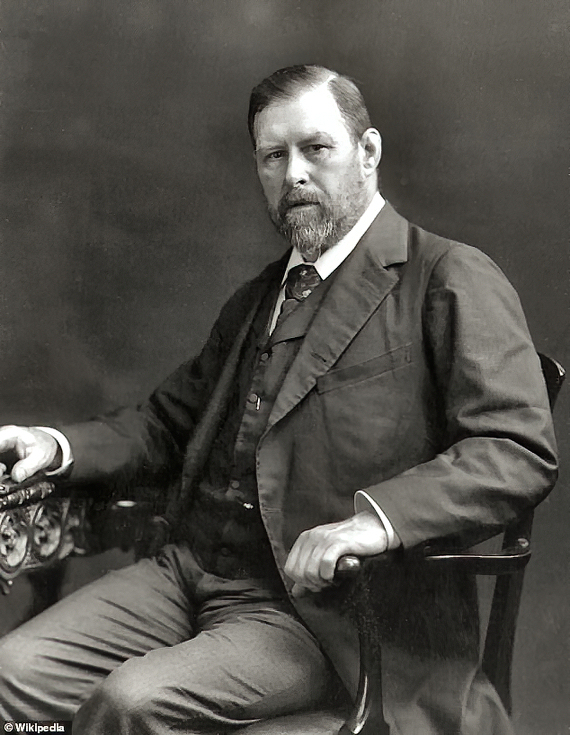
In 1897, an Irish writer by the name of Abraham (“Bram”) Stoker (Figure 1) wrote a gothic horror novel about a vampire. According to Wikipedia, Stoker was writing in the grand Victorian adventure tradition of people like Haggard, Kipling, Doyle, et al. He had spent years studying Eastern European folklore and apparently found the subject he was looking for in an 1885 essay by Emily Gerard called “Transylvania Superstitions,” which includes content about a vampire myth. Again, according to Wikipedia—and we all know that whatever we read on the internet is wholly trustworthy—the historical figure Vlad Dracula had little to do with Stoker’s work. Stoker’s book, which he titled Dracula (surprise!), although it appears he had originally had “Wampyr” as a tentative title. It was a modest success.
Early film producers found that Stoker hadn’t properly copyrighted the book, so this book was made into a 1922 movie called Nosferatu, starring Max Schreck as Count Orlok, the vampire, and directed by F.W. Murnau. (Alert readers will remember that in Batman Returns, Christopher Walken’s character was called Max Shreck. And really alert readers might recall the movie Shadow of the Vampire, about the making of Nosferatu, with Willem Dafoe as Max Schreck, the actor… and possible vampire.) Somehow or other Stoker got the rights thing straightened out and, since Nosferatu was basically a pirated movie/book, his heirs sued Murnau, and all copies were ordered destroyed. Thankfully for movie buffs, a few copies survived, and some pretty good copies can now be seen online. Between Dracula and Nosferatu, most of the modern ideas about vampires were put out.
Anyway, the book Dracula became very iconic in the 20th century (probably thanks to the movies), and any number of movie adaptations were made, with the best-known probably being James Whale’s 1931 adaptation starring Bela Lugosi. There have been serious remakes, comedic remakes, Blaxploitation remakes, and numerous reimaginings. The vampire, like the zombie and Frankenstein’s monster, has become an integral part of the modern horror canon. So in their search for things to monetize… er, produce, Netflix teamed up with the BBC to adapt and modernize the original Dracula character. The showrunners here, by the way, are Mark Gatiss and Steven Moffitt, who notably did the Benedict Cumberbatch Sherlock series.
**WARNING: If you haven’t seen it, and don’t like spoilers, stop here!**
The film begins in an almost sepia-toned village with the words “Hungary, 1897” superimposed, as the camera zooms in on a building with a spire, and into a corner room, where we see a fly on the windowpane as the camera turns to look out. Inside the room, the fly moves to the wall, then onto the camera itself, where its head is magnified in closeup to look like some kind of nightmarish beast! Then the fly flies off and we see a man in a white shift, sitting on a bed in some sort of cell, walled off by iron bars from the rest of the room. He is thin, bald, middle-aged-looking, with open sores. He looks like a concentration-camp survivor. He looks like he wants to catch the fly.
The peephole in the room’s door shows us a smiling face, then it closes and the door opens and a nun walks in, saying “Good morning, Mr. Harker. Are you hungry? My name is Sister Agatha.” She is tall, dressed in a light-blue nun’s outfit, with a long, pleasant face. She speaks with precision and authority.

We learn that this man is an English attorney named Jonathan Harker (John Heffernan). He has hand-written essentially a book detailing his adventures. It is a fairly thick stack of papers, but Sister Agatha (Dolly Wells)—who tells us her family name is Van Helsing—asks Jonathan for the story behind the story; she says that he has self-censored his tale in case it might be read by his fiancée, Mina Murray (Morfydd Clark), in London. She asks for the whole story, and he begins to talk. Harker is sent by his law firm to Transylvania, in order to assist with the title transfer of a London property to one Count Dracula (Claes Bang). He takes a photo of his fiancée to keep him company; although it was supposed to be a short trip, she has promised to wait forever for his return. Upon Harker’s arrival in Transylvania, the carriage dropped him more than a mile from Castle Dracula, telling him nobody goes any closer, but the coachman would find him. He eventually arrived at the castle and met the aged Count, who was very withered, with white hair, long nails, and looked rather decrepit. His English was also very stilted, though he promised Harker he would get better with Harker’s help. Somewhere in here we hear a version of Bela Lugosi’s statement to Harker in the earlier film, which was “…for the blood is the life!” This particular Count avers that “blood is lives.”
Although what we see in the first part of this three-parter is not quite as written by Stoker, in this first episode it is a very compelling rewrite, and made me want to see the rest very much. In this episode we find out that Sister Agatha, unlike most of her fellow nuns, didn’t take Holy Orders because of her love of God, or Christ, but rather “…how else is a middle-aged single woman to survive?” Her defining characteristic is one of curiosity: how does vampirism work? She asks Harker questions like “Did you have sexual intercourse with Count Dracula?” and avers that he has been exposed to a contagion unlike any other, and has been infected. We learn Harker’s whole story through flashbacks, as Sister Agatha presses him for more detail than is shown in his “book.”
Long story short: in episode 1, Harker journeys to Transylvania and meets the Count, who demands he stay after the papers are signed; he shows Harker that the castle is a maze, and says that, although he has business every day, he will leave Harker to explore on his own (“Treat my home as your own,” he says.). Harker, looking out his window once, sees a woman backing into a window above his own, and finds “help me” scratched into his window pane. Sister Agatha calls his attention to the fact that these words are in English. Harker vowed at that point (in the past) to find and help the unfortunate woman as his duty. Meanwhile, he is suffering from some kind of anomie, and has scars on his neck, while at the same time (we’re not surprised, even if he is) the Count’s English has improved tenfold and he is now seen as a much younger man with dark hair, as opposed to the decrepit oldster who first met Harker.
Harker finds hidden passages in the castle, and meets Dracula’s “brides”—the subjects from whom he expected to get an “heir” by sucking their blood and eventually conquer London. The locals have become flavourless, anyway. As Harker weakens, Dracula no longer keeps the truth from him; none of his “brides” (he keeps only three at a time) become what he is—a near-immortal—but exist as the living dead he keeps in boxes. They are unable to die unless staked through the heart. They are subject to his will, and experimented on by feeding them rats and other wildlife (and, one expects, the occasional castle visitor (Fuller Brush Man? Avon calling?) or unsuspecting villager. Finally, Harker nears death, but is able to escape Dracula by falling off the top of the castle into the river below.

Sister Agatha, meanwhile, has brought another nun as an observer, saying she is not trusted to be alone with a man. The observer, later, is revealed to be Mina Murray, Harker’s fiancée; Harker cannot remember her face, because he is revealed by Sister Agatha as being already dead. His so-called manuscript, or book, is revealed to be dozens of pages of scribblings like “Dracula is God,” “I must obey Dracula,” and so on. (Similar to The Shining’s “All work and no play makes Jack a dull boy.”)
Harker is one of the Undead now, unable to die, and would have been put into a box by Dracula if he hadn’t escaped. Unwilling to bear it, Harker grabs a wooden stake from Sister Agatha’s satchel, which is revealed to contain stakes and a hammer. Harker puts it into his own heart and falls to the floor. Meanwhile, Dracula has shown up at the convent, but Sister Agatha has forewarned the other nuns, and all are armed with wooden stakes. (Dracula first appears at the convent gates as a wolf, but Sister Agatha taunts him from the courtyard, saying she knows he cannot enter unless invited. And who would be so stupid? He drops the wolf guise, climbing nude and bloody out of the skin of the beast, but Sister Agatha continues to taunt him, because she knows he can’t get to her.
Dracula swears that he will kill the lot of them, but she and the other nuns are feeling superior, right up until… Dracula swoops in carrying the head of the Mother Superior! Who in a convent would or could possibly invite the Prince of Darkness in? Why, it was Jonathan Harker! As Dracula explains to an astonished Sister A (and Mina Murray), suicide is not an option for the undead! They must be killed by someone else, much as Dracula killed one of his “brides” in preparation for making Jonathan the third bride (he’s an equal opportunity bridegroom). So Harker invited Drac into the convent. As Sister A and Mina flee inside the convent, Dracula begins systematically slaughtering the other nuns, all of whom are in the courtyard.
The Sister and the fiancée take refuge in a corner office, where Sister A makes a semicircle of communion wafers across the doorway, assuring Mina that Dracula cannot cross these holy articles. She has previously talked about her lack of faith in God, but feels that perhaps Dracula’s aversion to holy relics like the cross and the wafers is a sign that God is alive and real. Whatever… she’s a very smart person and a survivor and will use whatever it takes. Until… Jonathan Harker appears, and Mina invites him in with the two women, telling Sister Agatha that she knows he could never hurt her, even as one of the Undead, because his love for her is true, and so on. Which would be totally cool, except that… it’s Dracula, inside Jonathan’s skin, which he is wearing just as he wore the wolfskin. To all outward appearances, it’s Harker, but he’s really dead now and Drac has stolen his skin, which he discards. He tells Mina to flee, and Sister Agatha, to give her time, offers herself as a willing victim. Fade to black.
That was a stellar rewriting, in my opinion, and made me want to see the other two episodes; I had no problem with them (Gatiss and Moffitt) changing all that stuff around; they kept the basics and invented some new stuff. It’s in the rest of the episodes that trouble rears its reinvented head. Episode 2 takes place, as in the book, on the Russian ship Demeter, on its way to England with a cargo of crates of “native soil.” Very little else in Episode 2 is like the original. Much of it invented out of whole cloth. And the finale (possibly of the series, more likely of the season) in Episode 3 is absolutely nothing like Stoker’s work, and mostly takes place in our present. It’s a serious letdown from the high hopes that were raised by Episode 1.
But that’s for a future column. If you haven’t already seen Dracula, I seriously suggest you watch only the first section, as the other two are disappointing, to say the least.
I welcome comments. Please—comment here, or on Facebook. Heck, drop me an email: my email is stevefah at hotmail dot com. Your comments, good or bad, positive or negative, are all welcome! (Just keep it polite, okay?) My opinion is, as always, my own, and doesn’t necessarily reflect the views of Amazing Stories or its owner, editor, publisher or other columnists. See you next time!











Steve, Again, a very interesting article about a story I’m not interested in! Let’s just say that you are a great writer, one who could probably interest 1950s kids in taking Caster Oil!
Thanks, Bill. I hope one of these days I’ll write about something you’re interested in! Thanks for reading!